Inside London Underground Tube carriages early-mid 20th century
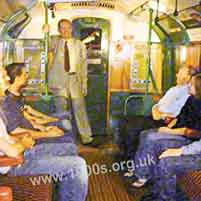
This page explores how much the passenger experience of inside London Underground Tube trains has changed over the years. There are images from the early and mid-20th century and firsthand recollections.
____
By the webmaster based on her early recollections with contributions from others who lived at the time
The London Underground was always known as the 'tube'. The only compartments that I knew in the 1940s were full-length, seating perhaps 50 passengers. In many ways, they were much as they are today, but there were significant differences:
Grips for standing passengers, lights and route maps
The trains got very crowded at times. So passengers had to stand. As the ride could be jerky, there were grips and poles for them to hang onto. Th first image below, which is probably from the 1930s shows grips consisting of dangling loops to slip one's hand through and support poles. There do not seem to be any route maps on display.
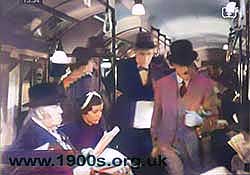
Inside a 1930s tube train showing passengers wearing clothes of the period. What will strike you will be the lighting system of light bulbs in glass lampshades.
The second image shows modern people sitting in a 1940s or early 50s tube carriage, apparently experiencing a presentation of some sort. The grips are black balls on a flexible strong metal springs. These are the sorts that I remember. Route maps are high up above the seats such that they can easily be read by the passengers opposite.
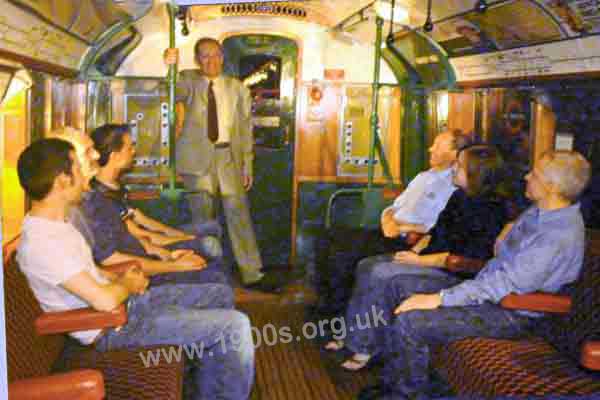
Inside a 1940s or 50s tube train showing the hanging ball-style grips and a man gripping a support pole. Detail from a photograph in the London Transport Museum.
Controls for guards and the emergency seat
Every compartment could, if necessary be placed at the back of the train and used for the guard. So the controls with their coloured buttons were plainly visible in every compartment - see the second of the above images and the detail below. They were a great temptation for children to press. I was always told not to, but I suspect that many a child did press, so they were probably disabled unless a guard was actually there.
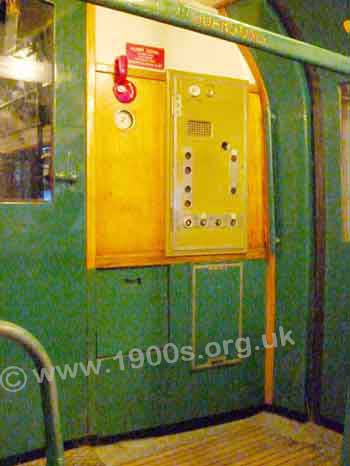
The controls for the guard, inside every tube compartment. Note the pull-down guard's seat, the red emergency-stop handle and the slatted wooden floor. Photographed in the London Transport Museum.
The guard's seat/the emergency seat
To the below-left of the controls was a pull-down spring-loaded seat presumably for the guard but known as the 'emergency seat' in all but the last carriage when no guard was there. It was hard and uncomfortable with no arms, but as a child I enjoyed sitting in it - and was always allowed to do so.
Protected windows in WW2
I certainly didn't spend my early childhood tube journeys looking out of the windows. Because it was wartime and London was in fear of German bombing, all the windows had creamy-looking mesh netting stuck over them to stop glass splinters flying from bomb blast. I very much wish I had a photo of those windows, but no museum I have seen shows them. Probably when the war stopped, they were so rapidly and eagerly stripped that no-one bothered to photograph them.
This mesh must have been fairly easy to buy, unlike non-essential items, because we had it up loosely at the windows at home in place of net curtains. New net curtains, being non-essential items, were no-where to be bought - and my parents had started to set up home only in the year before the beginning of the war.
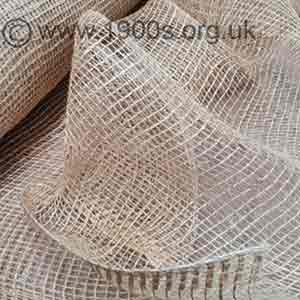
Train window net to protect against shattered glass in WW2 bombing
More about the netting on the train windows
contributed by Peter McDonagh
There were notices on trains about not peeling off netting:
Please do not peel the window netting. It is there for your protection.
Some graffiti added in response was:
Thank you for the information but I can't see the bloody station!
Tap/click for train windows on cross-country trains.
| sources | webmaster | contact |
Text and images are copyright
If you can add anything to this page or provide a photo, please contact me.



